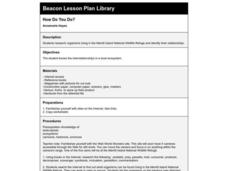Curated OER
The Environment and Interactions of Living Organisms
Students study the environment and interactions of living organisms. They identify abiotic and biotic factors and create a foldable and vocabulary cards. They create a poster illustrating soil and watch a video to study symbiosis.
Curated OER
Species Interactions
Eighth graders explore seven terrestrial biomes. They compare relationships between children, parents and friends to interactions among species. After observing pictures of types of interaction, 8th graders describe the predator-prey...
Curated OER
Cats
Students participate in an after school program that promotes communication with others, solving problems, and making decisions. They experience getting in touch with themselves, about cats, training cats, showing cats and explore...
Curated OER
Worm Interviews
Students identify types of worms. In this organisms lesson plan, students are shown slides of the different types of worms and take notes on each worm. Students answer questions about each worm.
Curated OER
Earth's Recyclers
Students work together in groups to report on different topics related to decomposition. They answer questions and share their answers with the class. They discuss any topic that is unclear.
Curated OER
How Do You Do?
Seventh graders research organisms in the Merritt Island National Wildlife Refuge. They create a picture book demonstrating their understanding of relationships.
Curated OER
Household Pests
Sixth graders discover the various habitat requirements for assorted household pests from ants to wasps. They conduct various activities including researching the life cycles moths, cockroaches, and mosquitoes
Curated OER
Saving Habitat
Students pick an animal native to Maryland and research how populations of that animal might be affected by land use changes over the past thirty years. They predict population trends for the next thirty years.
Curated OER
A Day in the Life
Students use their research skills to investigate the behavior and characteristics of a rainforest animal. After creating a diary entry, they illustrate the habits and life cycle of the animal. They write the diary entry from the point...
Curated OER
Mussel Movements
Students consider the impact of invasive species on local environments. In this ecology lesson, watch the video, Arizona Wildlife Views, which focuses on invasive species. Students develop vocabulary, relate to meaningful comprehension...
Curated OER
Habitats and Functions
Students analyze and discuss insect diversity and all of the functions that insects perform in nature. They examine habitat and function cards, and distribute themselves by function and habitat.
Curated OER
Black Pearls
Students examine where pearls come from and where mollusks are found. They discover how pearls are formed in nature and how they are they made by humans. They use ordinary oyster shells to examine mother of pearl.
Curated OER
Immune System Function
Students study the different facets of the Human immune system, including the functions of all the different organs in the immune system.
Curated OER
Fish Diseases
Students discuss sicknesses they have had or come in contact with. They discuss treatments for the diseases on the list. Students discuss illnesses that fish might get along with the symptoms, behavior and treatment.
Curated OER
Integrated Pest Management
Students compare and contrast the role of the honeybee in nature. They find information by using a variety of resources that could include the internet. Students take part in a paper and pencil formal evaluation with questions that...
Curated OER
Viruses and Host Evolution
Learners research viruses and their effects on the evolution of a rabbit population. They complete a teacher created worksheet of questions on their research. They present their research to classmates.
Curated OER
Spring Collecting and Identifying Bumble Bees
Students collect bumble bees in the field, record data, pin and label specimens, answer conclusion questions, and send specimens to research leaders for verification. They improve their ability to work in research teams. Students...
Curated OER
Spring Collecting and Identifying Bumble Bees
Students collect bumble bees in the field, record data, identify and release specimens, answer conclusion questions, and send data in to researcher leaders. They make research based conclusions based upon the evidence.
Curated OER
Fungi
Students study fungi and its parts. In this exploring fungi lesson students fill out a worksheet that includes a diagram of fungi and questions.
Curated OER
What Can I Do?
Students discuss feelings and ways to deal with problems. In this conflict resolution lesson, students identify their feelings and learn ways to resolve conflicts with others.
Curated OER
Massive Migrations
Here is an exciting exploration of a fascinating topic for your emerging ecologists: bird migration! They begin by visiting the US Fish & Wildlife Service website to discover which Arctic birds come to their areas. They are assigned...
Curated OER
Household Pests
Identify methods that prevent food-borne illnesses and contamination. National Standard 14.4.1 Identify food-borne illness Identify types of food-borne illness and their symptoms: botulism, e-coli, hepatitis, salmonella, staphylococci...
Curated OER
Food Web Follies
Seventh graders cut and paste animal pictures to create a food web and trace the path of energy. They write a paragraph explaining the importance of photosynthesis in all food webs.
























